Siyu Zhang
Toward Faithfulness-guided Ensemble Interpretation of Neural Network
Sep 04, 2025Abstract:Interpretable and faithful explanations for specific neural inferences are crucial for understanding and evaluating model behavior. Our work introduces \textbf{F}aithfulness-guided \textbf{E}nsemble \textbf{I}nterpretation (\textbf{FEI}), an innovative framework that enhances the breadth and effectiveness of faithfulness, advancing interpretability by providing superior visualization. Through an analysis of existing evaluation benchmarks, \textbf{FEI} employs a smooth approximation to elevate quantitative faithfulness scores. Diverse variations of \textbf{FEI} target enhanced faithfulness in hidden layer encodings, expanding interpretability. Additionally, we propose a novel qualitative metric that assesses hidden layer faithfulness. In extensive experiments, \textbf{FEI} surpasses existing methods, demonstrating substantial advances in qualitative visualization and quantitative faithfulness scores. Our research establishes a comprehensive framework for elevating faithfulness in neural network explanations, emphasizing both breadth and precision
Decoupling Continual Semantic Segmentation
Aug 07, 2025Abstract:Continual Semantic Segmentation (CSS) requires learning new classes without forgetting previously acquired knowledge, addressing the fundamental challenge of catastrophic forgetting in dense prediction tasks. However, existing CSS methods typically employ single-stage encoder-decoder architectures where segmentation masks and class labels are tightly coupled, leading to interference between old and new class learning and suboptimal retention-plasticity balance. We introduce DecoupleCSS, a novel two-stage framework for CSS. By decoupling class-aware detection from class-agnostic segmentation, DecoupleCSS enables more effective continual learning, preserving past knowledge while learning new classes. The first stage leverages pre-trained text and image encoders, adapted using LoRA, to encode class-specific information and generate location-aware prompts. In the second stage, the Segment Anything Model (SAM) is employed to produce precise segmentation masks, ensuring that segmentation knowledge is shared across both new and previous classes. This approach improves the balance between retention and adaptability in CSS, achieving state-of-the-art performance across a variety of challenging tasks. Our code is publicly available at: https://github.com/euyis1019/Decoupling-Continual-Semantic-Segmentation.
Seaweed-7B: Cost-Effective Training of Video Generation Foundation Model
Apr 11, 2025Abstract:This technical report presents a cost-efficient strategy for training a video generation foundation model. We present a mid-sized research model with approximately 7 billion parameters (7B) called Seaweed-7B trained from scratch using 665,000 H100 GPU hours. Despite being trained with moderate computational resources, Seaweed-7B demonstrates highly competitive performance compared to contemporary video generation models of much larger size. Design choices are especially crucial in a resource-constrained setting. This technical report highlights the key design decisions that enhance the performance of the medium-sized diffusion model. Empirically, we make two observations: (1) Seaweed-7B achieves performance comparable to, or even surpasses, larger models trained on substantially greater GPU resources, and (2) our model, which exhibits strong generalization ability, can be effectively adapted across a wide range of downstream applications either by lightweight fine-tuning or continue training. See the project page at https://seaweed.video/
Improving vision-language alignment with graph spiking hybrid Networks
Jan 31, 2025Abstract:To bridge the semantic gap between vision and language (VL), it is necessary to develop a good alignment strategy, which includes handling semantic diversity, abstract representation of visual information, and generalization ability of models. Recent works use detector-based bounding boxes or patches with regular partitions to represent visual semantics. While current paradigms have made strides, they are still insufficient for fully capturing the nuanced contextual relations among various objects. This paper proposes a comprehensive visual semantic representation module, necessitating the utilization of panoptic segmentation to generate coherent fine-grained semantic features. Furthermore, we propose a novel Graph Spiking Hybrid Network (GSHN) that integrates the complementary advantages of Spiking Neural Networks (SNNs) and Graph Attention Networks (GATs) to encode visual semantic information. Intriguingly, the model not only encodes the discrete and continuous latent variables of instances but also adeptly captures both local and global contextual features, thereby significantly enhancing the richness and diversity of semantic representations. Leveraging the spatiotemporal properties inherent in SNNs, we employ contrastive learning (CL) to enhance the similarity-based representation of embeddings. This strategy alleviates the computational overhead of the model and enriches meaningful visual representations by constructing positive and negative sample pairs. We design an innovative pre-training method, Spiked Text Learning (STL), which uses text features to improve the encoding ability of discrete semantics. Experiments show that the proposed GSHN exhibits promising results on multiple VL downstream tasks.
RP-SLAM: Real-time Photorealistic SLAM with Efficient 3D Gaussian Splatting
Dec 13, 2024Abstract:3D Gaussian Splatting has emerged as a promising technique for high-quality 3D rendering, leading to increasing interest in integrating 3DGS into realism SLAM systems. However, existing methods face challenges such as Gaussian primitives redundancy, forgetting problem during continuous optimization, and difficulty in initializing primitives in monocular case due to lack of depth information. In order to achieve efficient and photorealistic mapping, we propose RP-SLAM, a 3D Gaussian splatting-based vision SLAM method for monocular and RGB-D cameras. RP-SLAM decouples camera poses estimation from Gaussian primitives optimization and consists of three key components. Firstly, we propose an efficient incremental mapping approach to achieve a compact and accurate representation of the scene through adaptive sampling and Gaussian primitives filtering. Secondly, a dynamic window optimization method is proposed to mitigate the forgetting problem and improve map consistency. Finally, for the monocular case, a monocular keyframe initialization method based on sparse point cloud is proposed to improve the initialization accuracy of Gaussian primitives, which provides a geometric basis for subsequent optimization. The results of numerous experiments demonstrate that RP-SLAM achieves state-of-the-art map rendering accuracy while ensuring real-time performance and model compactness.
StreamMOTP: Streaming and Unified Framework for Joint 3D Multi-Object Tracking and Trajectory Prediction
Jun 28, 2024Abstract:3D multi-object tracking and trajectory prediction are two crucial modules in autonomous driving systems. Generally, the two tasks are handled separately in traditional paradigms and a few methods have started to explore modeling these two tasks in a joint manner recently. However, these approaches suffer from the limitations of single-frame training and inconsistent coordinate representations between tracking and prediction tasks. In this paper, we propose a streaming and unified framework for joint 3D Multi-Object Tracking and trajectory Prediction (StreamMOTP) to address the above challenges. Firstly, we construct the model in a streaming manner and exploit a memory bank to preserve and leverage the long-term latent features for tracked objects more effectively. Secondly, a relative spatio-temporal positional encoding strategy is introduced to bridge the gap of coordinate representations between the two tasks and maintain the pose-invariance for trajectory prediction. Thirdly, we further improve the quality and consistency of predicted trajectories with a dual-stream predictor. We conduct extensive experiments on popular nuSences dataset and the experimental results demonstrate the effectiveness and superiority of StreamMOTP, which outperforms previous methods significantly on both tasks. Furthermore, we also prove that the proposed framework has great potential and advantages in actual applications of autonomous driving.
NeB-SLAM: Neural Blocks-based Salable RGB-D SLAM for Unknown Scenes
May 24, 2024
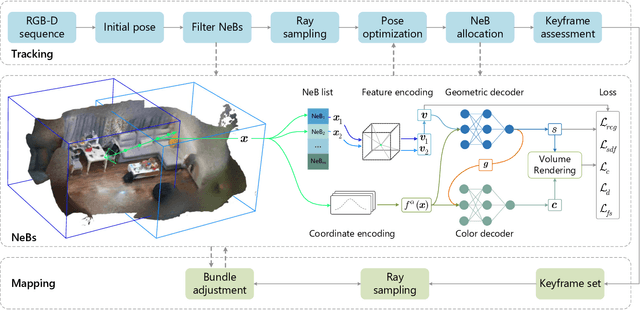
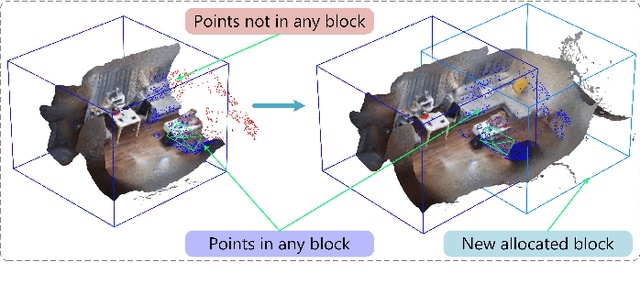
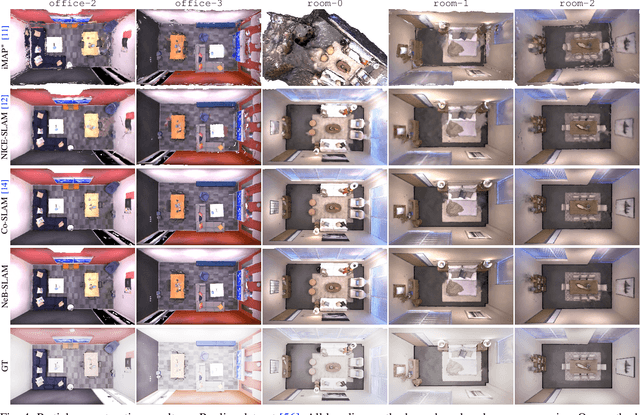
Abstract:Neural implicit representations have recently demonstrated considerable potential in the field of visual simultaneous localization and mapping (SLAM). This is due to their inherent advantages, including low storage overhead and representation continuity. However, these methods necessitate the size of the scene as input, which is impractical for unknown scenes. Consequently, we propose NeB-SLAM, a neural block-based scalable RGB-D SLAM for unknown scenes. Specifically, we first propose a divide-and-conquer mapping strategy that represents the entire unknown scene as a set of sub-maps. These sub-maps are a set of neural blocks of fixed size. Then, we introduce an adaptive map growth strategy to achieve adaptive allocation of neural blocks during camera tracking and gradually cover the whole unknown scene. Finally, extensive evaluations on various datasets demonstrate that our method is competitive in both mapping and tracking when targeting unknown environments.
SparseAD: Sparse Query-Centric Paradigm for Efficient End-to-End Autonomous Driving
Apr 10, 2024



Abstract:End-to-End paradigms use a unified framework to implement multi-tasks in an autonomous driving system. Despite simplicity and clarity, the performance of end-to-end autonomous driving methods on sub-tasks is still far behind the single-task methods. Meanwhile, the widely used dense BEV features in previous end-to-end methods make it costly to extend to more modalities or tasks. In this paper, we propose a Sparse query-centric paradigm for end-to-end Autonomous Driving (SparseAD), where the sparse queries completely represent the whole driving scenario across space, time and tasks without any dense BEV representation. Concretely, we design a unified sparse architecture for perception tasks including detection, tracking, and online mapping. Moreover, we revisit motion prediction and planning, and devise a more justifiable motion planner framework. On the challenging nuScenes dataset, SparseAD achieves SOTA full-task performance among end-to-end methods and significantly narrows the performance gap between end-to-end paradigms and single-task methods. Codes will be released soon.
Fast and Interpretable 2D Homography Decomposition: Similarity-Kernel-Similarity and Affine-Core-Affine Transformations
Feb 28, 2024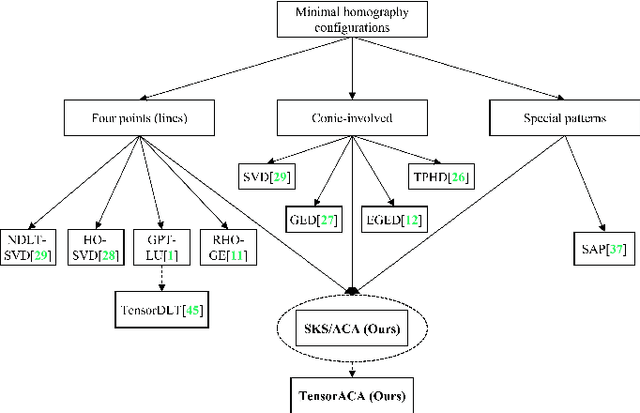

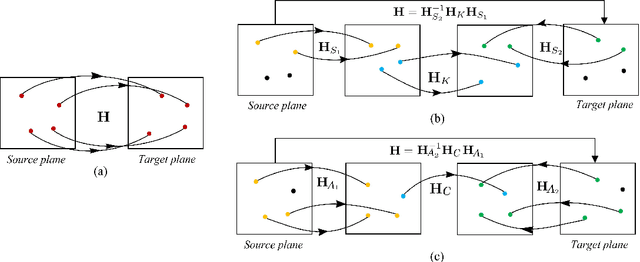
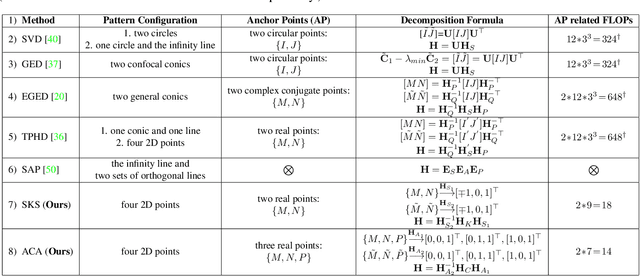
Abstract:In this paper, we present two fast and interpretable decomposition methods for 2D homography, which are named Similarity-Kernel-Similarity (SKS) and Affine-Core-Affine (ACA) transformations respectively. Under the minimal $4$-point configuration, the first and the last similarity transformations in SKS are computed by two anchor points on target and source planes, respectively. Then, the other two point correspondences can be exploited to compute the middle kernel transformation with only four parameters. Furthermore, ACA uses three anchor points to compute the first and the last affine transformations, followed by computation of the middle core transformation utilizing the other one point correspondence. ACA can compute a homography up to a scale with only $85$ floating-point operations (FLOPs), without even any division operations. Therefore, as a plug-in module, ACA facilitates the traditional feature-based Random Sample Consensus (RANSAC) pipeline, as well as deep homography pipelines estimating $4$-point offsets. In addition to the advantages of geometric parameterization and computational efficiency, SKS and ACA can express each element of homography by a polynomial of input coordinates ($7$th degree to $9$th degree), extend the existing essential Similarity-Affine-Projective (SAP) decomposition and calculate 2D affine transformations in a unified way. Source codes are released in https://github.com/cscvlab/SKS-Homography.
A Computationally Efficient Neural Video Compression Accelerator Based on a Sparse CNN-Transformer Hybrid Network
Dec 19, 2023



Abstract:Video compression is widely used in digital television, surveillance systems, and virtual reality. Real-time video decoding is crucial in practical scenarios. Recently, neural video compression (NVC) combines traditional coding with deep learning, achieving impressive compression efficiency. Nevertheless, the NVC models involve high computational costs and complex memory access patterns, challenging real-time hardware implementations. To relieve this burden, we propose an algorithm and hardware co-design framework named NVCA for video decoding on resource-limited devices. Firstly, a CNN-Transformer hybrid network is developed to improve compression performance by capturing multi-scale non-local features. In addition, we propose a fast algorithm-based sparse strategy that leverages the dual advantages of pruning and fast algorithms, sufficiently reducing computational complexity while maintaining video compression efficiency. Secondly, a reconfigurable sparse computing core is designed to flexibly support sparse convolutions and deconvolutions based on the fast algorithm-based sparse strategy. Furthermore, a novel heterogeneous layer chaining dataflow is incorporated to reduce off-chip memory traffic stemming from extensive inter-frame motion and residual information. Thirdly, the overall architecture of NVCA is designed and synthesized in TSMC 28nm CMOS technology. Extensive experiments demonstrate that our design provides superior coding quality and up to 22.7x decoding speed improvements over other video compression designs. Meanwhile, our design achieves up to 2.2x improvements in energy efficiency compared to prior accelerators.
 Add to Chrome
Add to Chrome Add to Firefox
Add to Firefox Add to Edge
Add to Edge